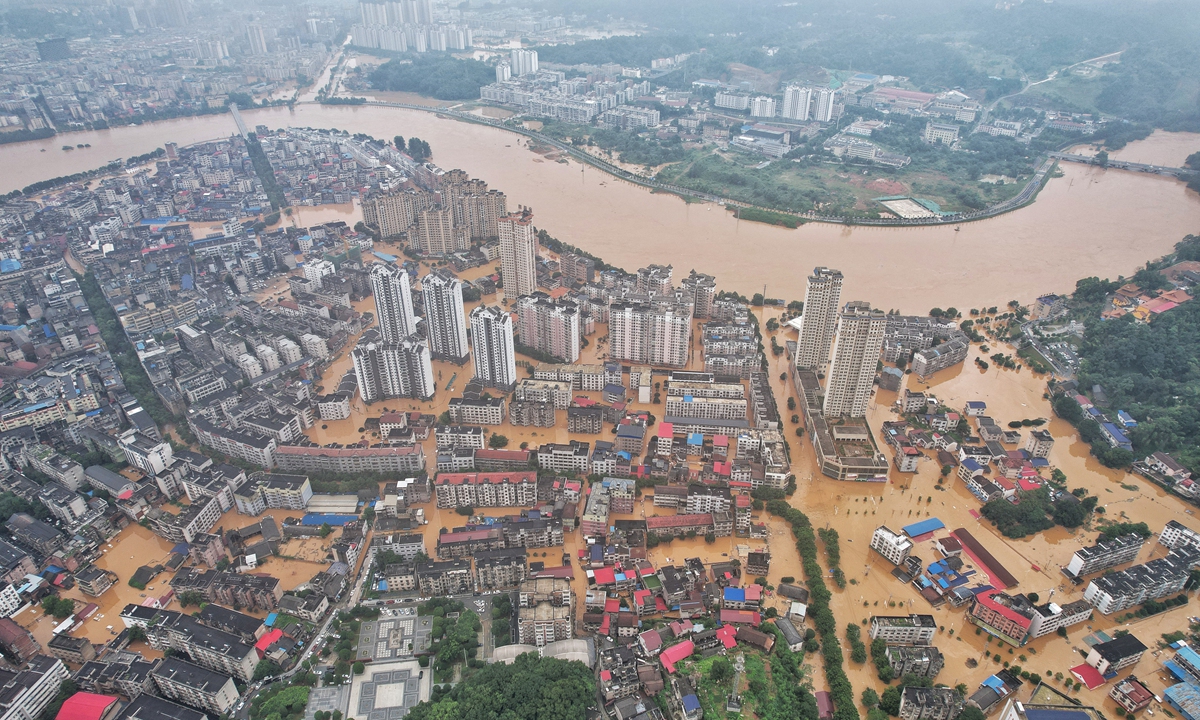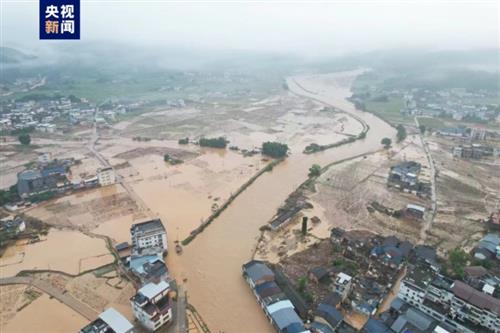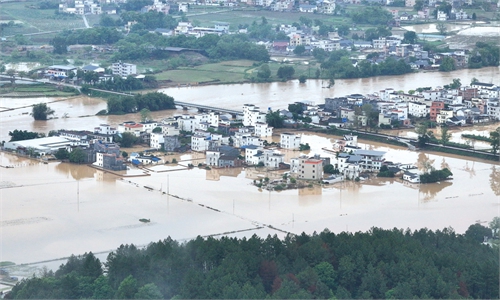
The county of Pingjiang in Yueyang, Central China's Hunan Province is suffering from severe flooding. Photo: VCG
As China enters flood season, water levels in sections of the middle and lower reaches of the Yangtze River - China's longest river - below the estuary of the second-largest Chinese freshwater lake Dongting Lake, have exceeded the warning mark, according to the Ministry of Water Resources on Tuesday.
With the Yangtze River predicted to see the water levels of its mainstream in the middle and lower reaches continue to rise, authorities across the country are trying their best to fight the flooding.
Chinese Premier Li Qiang inspected and supervised flood prevention efforts in Jiujiang, East China's Jiangxi Province, from Monday to Tuesday. Li emphasized that currently it is the peak flood season, and flood prevention has entered a critical stage. It is necessary to further strengthen risk awareness and bottom-line thinking, implement responsibilities, and strengthen coordination and cooperation, so as to fully ensure the safety of people's lives and property and the stability of society.
The Ministry of Water Resources has enacted a Level III emergency response for flood prevention in East China's Jiangxi and Anhui provinces, as well as Central China's Hunan and Hubei provinces, sending out working groups to guide flood prevention work on the frontlines, and using reservoirs to ease the pressure on flood control in the middle and lower reaches of the Yangtze River, according to the Xinhua News Agency on Tuesday.
South of the river, Pingjiang, a county that is home to 1.11 million people in Central China's Hunan Province, is facing the worst flooding seen in 70 years due to heavy rains, prompting local authorities to declare a state of wartime emergency on Monday night.
The Miluo river, which runs through Pingjiang county before merging with the Yangtze River, reached a height of 77.67 meters by early Tuesday morning, surpassing the alert level by over seven meters, and marking the highest water level recorded since 1954.
From 8 am on June 18 to 8 pm on July 1, the Pingjiang hydrometric station received 762.4 millimeters of rainfall, making it the longest, most intense, and heaviest rainfall event in the county since local meteorological records began in 1961.
Under the torrential rain and flooding, one-third of the old town area and half of the new town area of the county were submerged, Chinese media outlet The Paper reported on Tuesday.
On Monday night, local authorities raised the county's flood control emergency response to Level I, the highest possible level.
Due to heavy rainfall, urban waterlogging, landslides, and other factors, in order to ensure public transport passenger safety, at least 91 rural public bus routes and 11 bus routes in the county have all been suspended.
Fortunately, by Tuesday morning, the water level of the Miluo river had slightly receded and is expected to drop below the guaranteed level by early Wednesday. As of 2 pm on Tuesday, the water level in the county reached 76.51 meters, exceeding the warning level by 6.01 meters and the guaranteed upon level by 2.51 meters.
A resident surnamed Song from the county told the Global Times on Tuesday that in the low-lying rural areas, houses were submerged up to the roof, while in the county town, houses by the river were flooded up to the second floor and people are trapped on the same floor.
Many cars have been submerged in water while most areas in the county are without power, and the losses are devastating, Song said, noting that Pingjiang was a poverty-stricken county before 2020, with many senior citizens and children left behind. "This unprecedented flood is undoubtedly another blow to Pingjiang's development, just a few years after the country shook off poverty."
According to preliminary statistics, a total of 340,000 people in Pingjiang were affected, more than 2,600 bridges and roads were destroyed, five households completely collapsed, 11 households were seriously damaged, and nearly 170,000 mu (113.33 kilometers) of crops were affected, causing economic losses of more than 200 million yuan($27.5 million).
A total of 166 professional rescue teams, 15,539 flood rescue personnel, and 1,695 units of large-scale rescue equipment have been mobilized in the county to reinforce embankments, evacuate the flooded areas, and gradually arrange for the resettlement of the affected people, Chinanews.com reported on Tuesday.
At the forefront of flood prevention and disaster relief efforts, not only are rescue personnel giving their all, but they are also being aided by technological advancements such as drones and satellite communication.
Hunan Province has also allocated a total of 187 million yuan to support flood-stricken areas in flood control and disaster relief.
In other parts of China, it is predicted that in July, there may be significant flooding in the middle and lower reaches of the Yangtze River, the Yellow River, the Huai River, and other areas.
The water level of the middle and lower reaches of the river as well as Dongting Lake and Poyang Lake basins is expected to gradually fall after Friday, according to the Xinhua News Agency.




